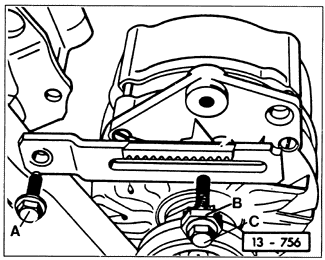5.3 Removing and Installing Alternator and Voltage Regulator
The alternator is connected to battery current even when the ignition is turned off. To prevent shorts and electrical damage, always disconnect the battery ground strap before removing the alternator.
To remove:
| 1. | Disconnect all wiring at the alternator. On some models there is a main connector plug held in place by a wire. On others, there is an insulator and two nuts that hold the wires to the alternator. If applicable, remove the screw that holds the suppression condenser to the regulator so that it is free from the alternator. |
| 2. | On diesel engines with air conditioning, remove the bolt that holds the protective cover to the front of the alternator and remove the cover. |
| 3. | Loosen the upper and lower alternator mounting bolts. Loosen the bolt that holds the alternator belt adjusting bracket to the cylinder head or the air-conditioning compressor's mounting bracket. |
| 4. | Push the alternator as far as possible toward the engine, then take the V-belt off the alternator pulley. |
| 5. | Remove the lower alternator mounting bolt, then remove the upper alternator mounting bolt and remove the alternator from the engine. |
Installation is the reverse of removal. Torque the nut on the D + terminal of the alternator to 3 Nm (27 in. lb.), and torque the nut on the B + terminal to 16 Nm (12 ft. lb.). On models with a toothed-rack adjusting mechanism, use a torque wrench and a 22 mm crowfoot wrench to tension the V-belt. Turn the larger part of the tensioning gear center bolt counterclockwise until the torque wrench reads 8 Nm (70 in. lb.) on used V-belts or 4 Nm (27 in. lb.) on new V-belts. Hold the wrench steady and tighten the center bolt to 35 Nm (26 ft. lb.). Torque the cylinder head bracket bolt to 20 Nm (15 ft. lb.) and the lower mounting bolt to 26 Nm (19 ft. lb.). See Fig. 5-2.
| Fig. 5-2. | Tensioning alternator V-belt on models with toothed rack adjusting mechanism. Make sure bolt A and bolt C are loose before adjusting tension. Place crowfoot wrench on outer part of bolt at B. |

|
On models without a toothed rack adjusting mechanism, adjust V-belt tension by pushing the alternator away from the engine until the belt can be depressed as shown in Fig. 5-3. When the tension is correct, torque both adjusting bracket bolts to 25 Nm (18 ft. lb.). Torque the lower mounting bolt to 30 Nm (22 ft. lb.).
